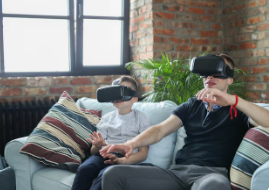Virtual Reality (VR) and Augmented Reality (AR) are two groundbreaking technologies that are transforming how we interact with the world. These technologies blend the physical and digital realms, creating immersive experiences that enhance how we perceive and engage with our environment. This article explores the fundamentals of VR and AR, their applications across various industries, and the potential future impacts.
Understanding VR and AR:
Virtual Reality (VR): Virtual Reality is a fully immersive experience that simulates a real or imagined environment. Using VR headsets like the Oculus Rift or HTC Vive, users can explore and interact with a 3D world that completely replaces their physical surroundings. This immersive environment is achieved through the integration of audio-visual elements and interactive components, creating a sense of presence and immersion.
Augmented Reality (AR): Augmented Reality overlays digital information onto the real world, enhancing the user's perception of their environment. Unlike VR, which creates an entirely virtual world, AR supplements the real world with digital elements such as images, videos, and sounds. AR can be experienced through devices like smartphones, tablets, and AR glasses, with popular examples including the Pokémon GO game and Google Lens.
Applications of VR and AR:
Gaming and Entertainment:
- VR has revolutionized the gaming industry by providing immersive gameplay experiences that transport players into virtual worlds. Games like Beat Saber and Half-Life: Alyx offer fully interactive environments that enhance user engagement.
- AR enhances traditional gaming by integrating digital elements into the physical world. Pokémon GO is a prime example, where players hunt for virtual creatures in real-world locations.
Education and Training:
- VR offers immersive educational experiences, allowing students to explore historical sites, conduct virtual science experiments, and engage in interactive learning. For example, medical students can practice surgeries in a virtual environment before performing on real patients.
- AR aids in training by overlaying instructions and guidance onto physical objects. This is particularly useful in fields like engineering and mechanics, where trainees can see step-by-step instructions overlaid onto machinery.
Healthcare:
- VR is used in therapy and rehabilitation, helping patients overcome phobias, manage pain, and recover from physical injuries through virtual exercises and environments.
- AR assists surgeons by overlaying critical information onto the patient during procedures, improving accuracy and reducing risks.
Retail and Marketing:
- VR enables virtual shopping experiences where customers can explore stores and try on products from the comfort of their homes. Brands like IKEA offer VR apps for customers to visualize furniture in their living spaces.
- AR enhances marketing campaigns by allowing consumers to interact with products in innovative ways. For instance, AR apps can let users see how a new piece of furniture would look in their home before purchasing.
Real Estate and Architecture:
- VR allows potential buyers to take virtual tours of properties, providing a realistic sense of space and layout without needing to visit in person. This technology is also used in architecture to visualize building designs and modifications.
- AR helps architects and builders visualize construction projects in the real world, overlaying digital models onto physical spaces to assess designs and make adjustments.
Manufacturing and Maintenance:
- VR is used for training factory workers and technicians, simulating machinery operations and maintenance procedures in a safe virtual environment.
- AR aids in maintenance by providing real-time information and guidance. Technicians can view schematics and instructions overlaid onto equipment, improving efficiency and accuracy.
Challenges and Limitations:
Technical Limitations:
- VR and AR require high-performance hardware to deliver seamless experiences. This includes powerful processors, high-resolution displays, and precise tracking sensors.
- Battery life and processing power are significant challenges for AR devices, especially wearable technology like AR glasses.
User Experience:
- VR can cause motion sickness and discomfort for some users due to the disconnect between visual input and physical sensations.
- AR experiences can be limited by the field of view and accuracy of the digital overlays.
Content Creation:
- Developing VR and AR content is complex and resource-intensive, requiring specialized skills in 3D modeling, animation, and software development.
- Ensuring a steady stream of high-quality content is crucial for maintaining user engagement and adoption.
Privacy and Security:
- Both VR and AR collect extensive data about users and their environments, raising concerns about privacy and data security.
- Protecting sensitive information and ensuring ethical use of data are critical considerations for widespread adoption.
Future Prospects:
The future of VR and AR is promising, with advancements in technology poised to overcome current limitations and unlock new possibilities. Key trends shaping the future include:
Improved Hardware:
- Next-generation VR headsets and AR glasses will offer higher resolution, better field of view, and more natural interactions. Advances in lightweight materials and battery technology will enhance comfort and usability.
Artificial Intelligence:
- AI will play a significant role in enhancing VR and AR experiences, enabling more realistic simulations, personalized content, and intelligent interactions.
5G Connectivity:
- The rollout of 5G networks will provide the high-speed, low-latency connections needed for seamless VR and AR experiences, enabling real-time data processing and cloud-based applications.
Expanded Applications:
- As technology matures, VR and AR will find broader applications across industries, including remote work, telemedicine, tourism, and social interaction.
Conclusion:
Virtual Reality and Augmented Reality are transforming how we interact with the world, bridging the gap between the physical and digital realms. These technologies offer immense potential across various industries, enhancing experiences and driving innovation. While challenges remain, continued advancements in hardware, software, and connectivity promise a future where VR and AR are integral parts of everyday life. By embracing these technologies, we can create new opportunities for learning, collaboration, and exploration.

